flaminglasrswrd
Harmless

Posts: 9
Registered: 17-9-2019
Member Is Offline
|
|
PET to Terephthalic Acid with Ethaline: 60% yield; 79% conversion
Hey everyone! Long time lurker, first time poster. Just thought I would share a small success.
I've been doing some research with Deep Eutectic Solvents lately. They are remarkable substances with wide ranging applicability. They are especially
suitable for the amateur because they can act as solvent and catalyst while being environmentally friendly, cheap, and safe to handle. They are
successors to Ionic Liquids, but are safer to handle, more stable, and easier to make.
In this particular instance, I was attempting the hydrolysis of PET to terephthalic acid with future plans to produce benzene. This is a continuation
of the work with ILs shown here and here.
The DES I used for this reaction is called Ethaline: A one to two molar ratio of Choline Chloride and Ethylene Glycol. Simply combine the two, heat to
about 70C for a few hours with mixing, and you have your DES. I chose Ethaline because the hydrolysis of PET should liberate EG that won't contaminate
the DES.
So I started the experiment by grinding recycled PET in a blender (two egg and one strawberry carton). From the literature, it seems that the
solubility of PET in the DES is the limiting factor, so I attempted to make it as fine as possible. I stopped when it was approximately the size of
play sand because my blender was overheating. The total PET used was 105.42g.
The PET was added to a 1L flask along with 139.62g Choline Chlorine and 62g ethylene glycol. This wasn't enough to fully cover the PET so I added some
previously made Ethaline (same ratio). Total volume was about 450ml.
I had intended to heat the mix to 160-180C for 12 hours, but was interrupted part way through. So I just kind of guessed when the mix was done and
turned off the heating. All told, the flask was heated to 160C for 4 hours, turned off for 9 hours, heated to 170C for 6 hours and then 180C for 4
hours. If you are going to repeat this procedure, just heat the flask to 180C for 10-12 hours.
After everything was cooled, about 200ml of water was added to precipitate the TPA. The whole thing was filtered and rinsed several times with water.
Then two moles (overkill) of sodium hydroxide as a solution was added to dissolve the TPA as the disodium salt. The solution was filtered again to
remove the unreacted PET and contaminants. The solution was left overnight.
In the morning a small amount of brown precipitate had formed so I filtered again to yield 1L of pale yellow-brown solution. I'm unsure if this
contaminant is from the PET or the DES.
Since I plan on taking this synth all the way to benzene, I only took a small sample to judge yield and left the rest. Upon precipitation with ~2ml of
31% hydrochloric acid, the 9.9ml sample produced 0.55g of dry, fluffy, white TPA. So the entire 1L batch should contain about 55g of recoverable TPA.
The unconverted PET was dried to give a sand-like mix. Total weight: 24.34g.
So of the 105g (0.55mol) PET, 55g (0.33mol) TPA was produced with 24.34g leftover: A yield of 60% and conversion of 79%.
In the future I plan on reusing the Ethaline and unreacted PET for another run and converting the TPA to benzene using a different DES. Also, a
replication of this process using a urea based DES instead might give higher yields.
There are some notes on my website if you don't mind reading something so unorganized. I also have some notes on a successful test run for decarboxylating niacin with
Ethaline as well.
Anyway, just thought you guys would appreciate my work. More to come...
Image 1: The flask after the reaction has finished before water addition.
Image 2: Filtering the precipitated TPA and unreacted PET
Image 3: Unreacted PET and contaminants
Image 4: Precipitated sample of TPA
Image 5: Dried sample of TPA
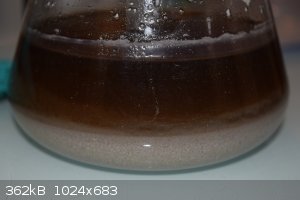 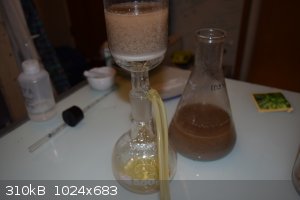 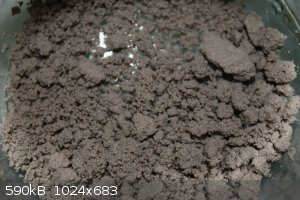 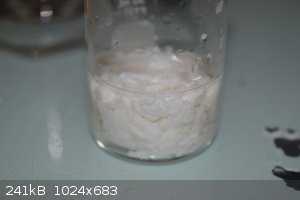 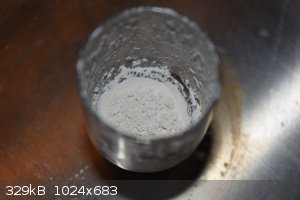
|
|
|
Pumukli
National Hazard
   
Posts: 686
Registered: 2-3-2014
Location: EU
Member Is Offline
Mood: No Mood
|
|
Flaminglasrswrd, as a "friend" of PET and aromatic carboxylic acids in general, I very much appreciate your work! 
Keep up and keep us posted!
|
|
|
monolithic
Hazard to Others
  
Posts: 435
Registered: 5-3-2018
Member Is Offline
Mood: No Mood
|
|
Very cool project. 
|
|
|
draculic acid69
International Hazard
    
Posts: 1371
Registered: 2-8-2018
Member Is Offline
|
|
Nice work. very interesting. I'm a big fan of work in this area.good to see I'm not the only one
|
|
|
RedDwarf
Hazard to Others
  
Posts: 161
Registered: 16-2-2019
Location: UK (North West)
Member Is Offline
Mood: Variable
|
|
Do you have a cheap/easily available source of Choline Chloride, and are you aware of any DESs that use something more easily available than Choline
Chloride?
|
|
|
Ubya
International Hazard
    
Posts: 1232
Registered: 23-11-2017
Location: Rome-Italy
Member Is Offline
Mood: I'm a maddo scientisto!!!
|
|
what is the advandage of using ethaline instead of plain ethylene glycol as it's usually done?
---------------------------------------------------------------------
feel free to correct my grammar, or any mistakes i make
---------------------------------------------------------------------
|
|
|
Praxichys
International Hazard
    
Posts: 1063
Registered: 31-7-2013
Location: Detroit, Michigan, USA
Member Is Offline
Mood: Coprecipitated
|
|
Welcome, flaminglasrswrd, and great work; you'll fit right in here.
I am very interested in your plan to use DES to convert plastics to benzene. There are several papers I have seen where raw plastic was pyrolyzed in a
quartz tube and the distillate analyzed. In many cases the benzene content is very high. Some kind of steel container with a condenser stuffed with
plastic waste sitting on a campfire will yield a wealth of aromatic products. The only real challenge is separating them effectively.
https://www.hindawi.com/journals/jpe/2013/987568/
"the maximum yield of total gas obtained at 800°C from HDPE pyrolysis is 94.5% with the following composition: 20% methane, 3.8% ethane, 37%
ethylene, 0.2% propane, 4.7% propylene, 0.3% butane, 0.4% butylenes, 2.2% pentane, 24% benzene, 2.1% toluene, 0.01% acetylene, and
0.02% xylenes and styrene"
Note that the majority of the distillate is gaseous at room temperature; therefore the majority of the liquid collected will be BTX at greater than
89% benzene and might be quite separable with an efficient packed column.
I am very interested to see if a new route to benzene using a DES might have a >24% total yield.
[Edited on 24-9-2019 by Praxichys]
|
|
|
flaminglasrswrd
Harmless

Posts: 9
Registered: 17-9-2019
Member Is Offline
|
|
Quote: Originally posted by RedDwarf  | | Do you have a cheap/easily available source of Choline Chloride, and are you aware of any DESs that use something more easily available than Choline
Chloride? |
I buy choline chloride on ebay. 500g for $30.
There are quite a few DES's that are worth looking into. None of them are as extensively studied as Ethaline, however, which is why I started with it.
ChCl is produced industrially as a feed additive, so I imagine the price could come way down if there is more demand.
Quote: Originally posted by Ubya  | | what is the advandage of using ethaline instead of plain ethylene glycol as it's usually done? |
DES's are catalysts as well as solvents. The original procedure by CHROMIUM requires a steel container because of the NaOH etching problem. This
method can be done with standard glassware. Plus the molar excess of NaOH has to be neutralized for recovery. Ethaline should be able to be reused
multiple times after a quick filter and drying.
I hope with future research, I can reduce the temperature required and provide an easier workup. The original base-acid procedure was mostly for
determining yield and conversion. Since the goal is benzene, workup for terephthalic acid should be unecessary. I'm looking into either urea or zinc
chloride as possible hydrogen bond acceptors in the future.
|
|
|